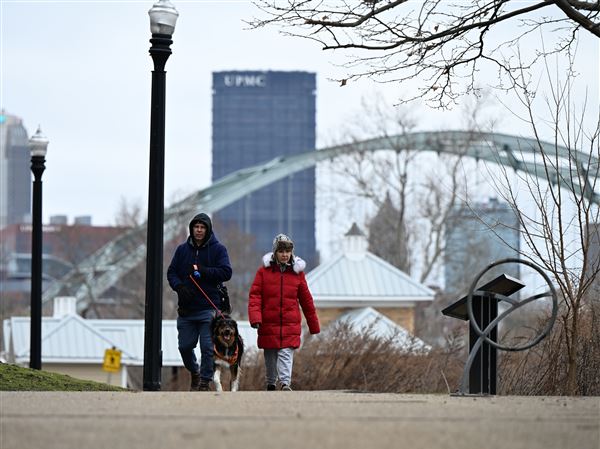First of a two-part series
Caught on a Downtown street corner selling one of his clonazepam pills for $3, Gary W. Miller started down a path that would end 22 months later with his death, at age 54, in the Allegheny County Jail.
He died, according to three other inmates, in a urine-soaked isolation cell, too disoriented to know where he was. That ended a days-long period during which liver disease rendered him unable to eat independently, shower or change his soiled undergarments.
"What a shame he had to die that way, all alone, in a urine-stained room," two inmates wrote in a letter to Allegheny County Health Department Director Bruce Dixon, who is also chairman of the board of Allegheny Correctional Health Services.
That nonprofit offshoot of the county has, for a decade, handled health care at the jail, at a cost of around $12 million a year. On its watch, the jail was one of the dozen deadliest among the nation's 50 largest county jails from 2000 through 2007, and its five deaths in each of 2009 and 2010 gave it a mortality rate more than twice the state average.
"I'm not sure why that is," said Dr. Dixon last week. An outsized number of the deaths are suicides, he noted. "We're constantly trying to see how we can better screen people who are at risk for suicide."
Shown the inmates' letter on Mr. Miller's death, he said it would be investigated.
"It sounds to me like there were some issues here," he said, "that need to be addressed."
Gary Miller worked painting barges for years, according to his longtime companion, Rita Rave of Stowe, and in his spare time cheered the local sports teams and listened to his favorite music, the '70s art rock band Yes. "He adored his children," said Ms. Rave, showing off pictures of him with their two daughters on playgrounds. He remained involved even after they lost custody of the daughters in 2006.
He did not, however, lead a healthy life.
He had drug and drinking problems. From 1995 through 2003, he pleaded guilty to drug possession, drunken driving, theft, receiving stolen property and writing bad checks. In 2007 Ms. Rave accused him of relapsing into drug use, threatening her and smashing her religious icons, but she later withdrew her request for protection from abuse.
He suffered from cirrhosis and hepatitis C, and in 2004, according to Ms. Rave, a doctor told him that he had six months to a year to live. He beat that prediction, but every six to eight weeks, on average, his blood ammonia levels would get too high and he'd end up in the hospital.
In April 2008 he had been out of legal trouble for five years, and sober for a while, when he and Ms. Rave ran out of both cigarettes and money. To raise a few dollars, he went Downtown with a bottle of clonazepam, prescribed to him for panic attacks, and sometimes valued by street drug users for its sedative effects. Police picked him up after seeing him sell one pill. They found $3 in his pocket, according to the criminal complaint.
He pleaded guilty, and was ordered to an inpatient drug treatment facility. In 2009, though, he was found to be out of compliance with his probation terms, and warrants were issued for his arrest. He was jailed on Oct. 29, 2009.
"One in every 100 Americans is behind bars today, and four in every 100 Americans is going to be behind bars some time this year," said Mark Stern, former medical director for the Washington Department of Corrections, now a public health professor at the University of Washington. Inmates are constitutionally entitled to professional care for their serious health needs, he said, and taxpayers must cover the bill.
In many jails, health care is contracted to a private firm. Allegheny County had such an arrangement until 2000, when a contractor's term ran out.
Dr. Dixon and then-County Executive Jim Roddey created Allegheny Correctional Health Services in hopes of controlling costs that were then $4.6 million a year, and improving the quality of care, including better drugs for mentally ill patients.
It's a tough job. The jail typically holds 2,600 to 2,700 inmates, ranging from accused murderers awaiting trial, to people who didn't pay child support. Allegheny Correctional performs some 26,000 intake screenings a year.
"They have a right to adequate medical care," then-Warden Ramon Rustin said in January, before he left to run a jail in New Mexico. He has not yet been replaced. "When we get them, they're in serious need of medical attention. ... Their systems are so torn down."
Allegheny Correctional runs a small infirmary and a staff of around 120 spread throughout the jail, including five physicians, three psychologists, three dentists, and nurses, clerks, hygienists and social workers. It is led by Chief Operating Officer Dana Phillips, a former speech therapist with experience in nonprofit management.
From the $7.35 million budgeted for 2005, costs climbed to $11.45 million in 2008, before leveling off. Last year, the county paid Allegheny Correctional $11.91 million.
"If you want cheap care," said Dr. Dixon, "you're going to exchange lawsuits for care."
For every day that an inmate was incarcerated at the Allegheny County Jail, taxpayers paid more than $12 for medical care alone. While that's less than some jails, it's more than the $7 to $9 per inmate/day costs of a handful of other midsize to large jails in the state with privatized health care that responded to Post-Gazette record requests on their costs.
Montgomery County Correctional Facility Deputy Warden Dennis Molyneaux said that facility -- which spends around $8 on health care per inmate per day -- rebids its contract every three to four years. On an average day it holds around 1,750 inmates, and in 2009 and 2010 it saw a total of two deaths.
Allegheny Correctional's mortality rate has been consistent throughout the decade, at around two deaths per year for every thousand inmates per day. That mortality rate is higher than other large Pennsylvania jails, and higher than most big jails nationally.
Mortality rates can be influenced by the age and illness of the inmate population, said Dr. Stern, but it is still a rough measure of a jail's health-care effectiveness. "Over time, if you have a large population, mortality rate can be informative, and can tell you something about quality."
It can also reflect different views on whether jail is an appropriate place to die.
Some jails arrange with the courts to furlough inmates with serious medical problems, said Dr. Dixon. "I don't foster that attitude, by any means," he said.
He said that if Allegheny Correctional staff believes an inmate is terminally ill, they'll be "compassionate, and we'll try to get them released" if the charges against them don't preclude it. He is not, though, an advocate of sending inmates to hospitals just to die.
The opposite philosophy is in place at the jails in Orange County, Calif., which have some of the lowest mortality rates in the country. The deputy director of that county's health agency, Kathryn J. Wild, a registered nurse, said she's a believer in "compassionate release" of sick inmates to home detention, and will sometimes spend money to hospitalize terminal inmates.
She cited a recent case in which courts declined Orange County's request to send home an inmate with terminal liver disease.
"Eventually, he was bedridden, and he needed certain equipment that we could not provide, like cooling sheets, and he was on multiple IVs," she said. "We couldn't have provided that skilled level of nursing that he needed." Though he was doomed, she hospitalized him.
"I think that's the right thing to do, and their family can be with them," she said.
Deaths in jail generate lawsuits, but not jackpots.
That's because courts have ruled that negligence by correctional doctors and nurses isn't enough to trigger a violation of constitutional rights. To make the case that medical decisions amounted to "cruel and unusual punishment," plaintiff's attorneys need to show that jail officials "must have known of the risk to inmate health" but ignored it anyway, said Steve Barth. He's an attorney with Downtown-based Goodrich & Goodrich, which has filed several lawsuits against the jail and Allegheny Correctional.
Despite that high bar, the county and Allegheny Correctional have settled several death cases in recent years.
They paid a combined total of $650,000 to settle civil lawsuits stemming from the 2005 deaths of Amy Lynn Sartori, 31, and Valeria Whetsell, 50. They died within nine hours of each other, of pneumonia and fatigue, after their respiratory problems were ignored, their survivors alleged, and they were ordered to clean jail floors with caustic cleansers.
Approved in March by the Orphan's Court Division of Common Pleas Court was a $50,000 settlement by the county and Allegheny Correctional in the 2006 death of Donald Vargo. Jailed for drunk driving, he had left hand numbness, according to his civil complaint, which jail officials ignored. He died there of heart disease.
Among the nation's 50 biggest jails, Allegheny County's ranked second in the prevalence of suicide from 2000 to 2007, according to the Bureau of Justice Statistics.
"We've had some suicides on occasion that I think could've been handled better," Dr. Dixon said. He said a relatively new practice is to identify new inmates who seem to be suicide risks, and make sure they have a cell mate, reducing the likelihood that they'll kill themselves.
The county and Allegheny Correctional now face civil lawsuits accusing them of negligence leading up to three suicides in jail, all driven, according to the estates of the deceased, by failures to provide medical treatment.
John Simeone III, then 36, was a narcotics addict who went into withdrawal in jail and hung himself in late 2007, according to his estate's complaint. Committing suicide in 2008 were Jason Kindler, 28, who was deprived of psychiatric medicines and hung himself; and Shiva Lal Acharya, 33, who sought medicine for alcoholism and mental illness before committing suicide while alone in a cell, according to their complaints.
Amy Lynn Gillespie, 27, was jailed after she violated halfway house rules by becoming pregnant. She complained of breathing problems in late December 2009, according to her mother's lawsuit, but was denied access to UPMC Mercy Hospital until Jan. 10, 2010. She died of pneumonia three days later, as did her fetus.
Women's advocates marched after the lawsuit was filed, some demanding a new jail for women, with better health care. Discussions have stalled since Mr. Rustin's departure.
Liver failure is one of the biggest problems in correctional medicine today, according to Ms. Wild, thanks to the prevalence of hepatitis C and cirrhosis among intravenous drug users and alcoholics.
That's the combination that killed Gary Miller, according to the Allegheny County medical examiner's office.
Dr. Dixon said last week that until the Post-Gazette brought it to him, he had never seen the inmates' letter describing Mr. Miller's last days. He said all jail deaths are reviewed, and he sometimes gets personally involved, but he did not remember being apprised of details of Mr. Miller's passing.
A patient in his condition "may die in jail," Dr. Dixon said, "but it can't be inhumane."
Inmate Mark Huellen wrote the letter, which was also signed by inmate Ronald A. Rizzo. The Post-Gazette was able to corroborate it through a third inmate, and a former Allegheny Correctional employee.
"Over a period of about days day's time Mr. Miller's health had gone from what seemed to be OK to him being disoriented and unaware of his surroundings," the letter said. The letter described him stripping, urinating on the floor, having difficulty getting to breakfast, and becoming "more and more disoriented and out of touch with reality as time went on to the point where he could not eat, wash himself or even understand who he was."
Medical staff didn't "help him or address any of these issues that were completely out of character of Mr. Miller's behavior," according to the letter. Mr. Huellen wrote that he "took it upon myself to help clean Mr. Miller up by placing him in the shower and physically washing him while the whole medical staff proceeded to do nothing but watch me with no offer to assist."
The two inmates "personally cared for Mr. Miller by feeding him, bathing him, changing his linens and blankets, making sure his protective undergarments were not soiled, and even making sure he would take his medications at times," said the letter. With the exception of the ministrations of one nurse, Mr. Miller was "left to rot away with soiled clothing, no food, feces and urine all over him and his room until [we] would clean it up."
Another inmate who was in the infirmary then, and who asked not to be named, said that a jail doctor saw Mr. Miller. But then jail staff "put him in an isolation cell, basically just put him there to die," he said.
"At least the night before, he got to eat two peanut butter sandwiches, two trays of pasta, and something to drink," Mr. Huellen wrote. "And today Mr. Miller was spared the suffering when he was found deceased in his cell."
Staff tried to revive Mr. Miller with CPR but failed.
"He was really looking forward to seeing his daughter go to college," Ms. Rave said, referring to their older daughter, now age 14. "He promised me we would grow old together."
Monday: Inmates say they can't get medicine, hospital help.










 PG CHART
PG CHART








